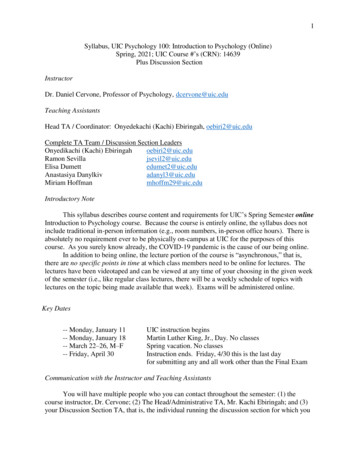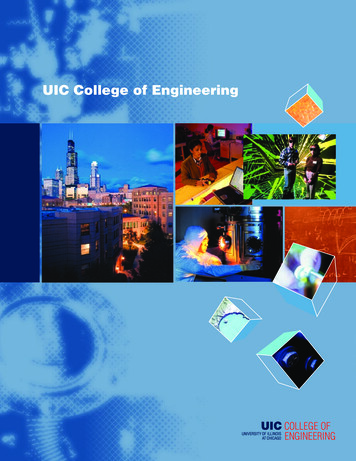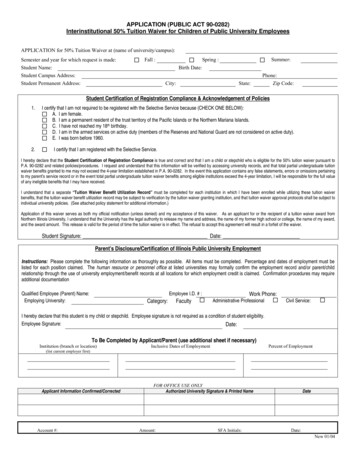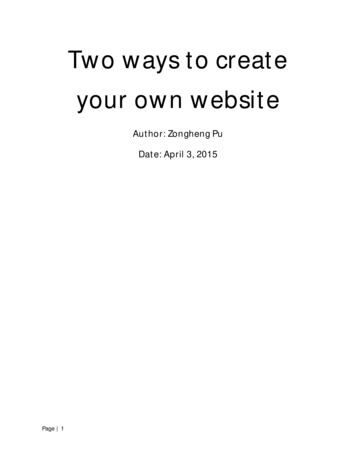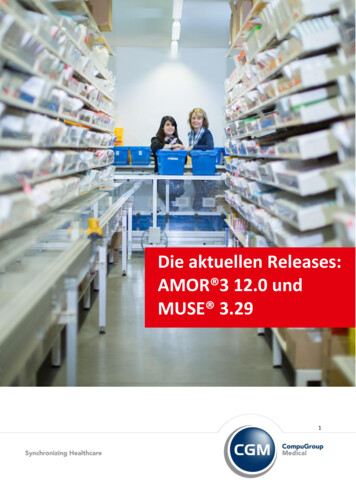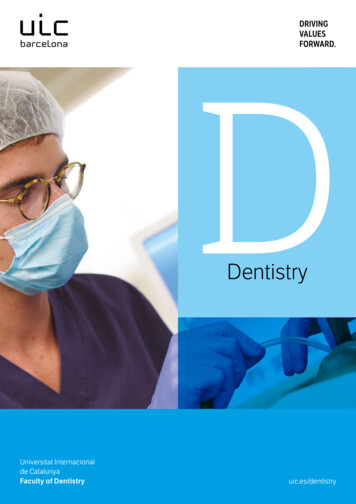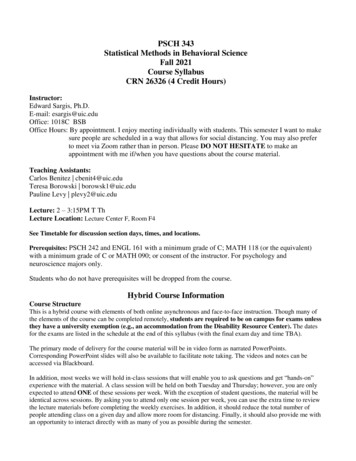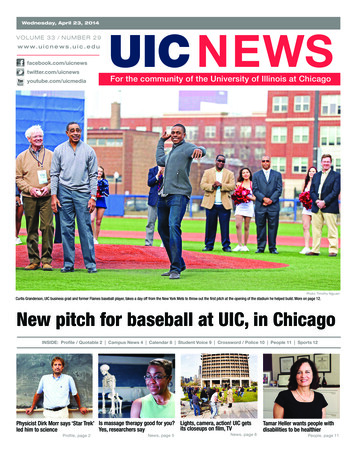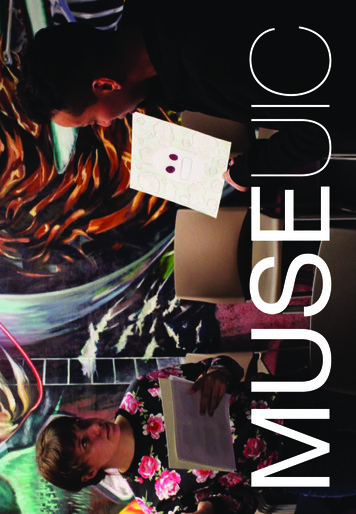
Transcription
MUSEUIC
MASTEROF ARTS INMUSEUMANDEXHIBITIONSTUDIES
Welcome to MUSE, an interdisciplinary graduate programwith a social justice focus. MUSE emphasizes the evolvingsocial and political contexts of today’s cultural institutions,including museums of art, anthropology, architecture, history,nature, science, youth and contemporary culture, and providesstudents with the intellectual and professional engagementsessential to careers in diverse positions, including curators,exhibition developers, gallery directors, museum educators,collections managers, and social media directors.MUSE students take five required courses addressing exhibitionmaking, collections, writing for exhibitions, strategies of publicengagement, and museum genres and histories; do a supervisedinternship; participate in skill-developing projects; and completea capstone during the two-year program.MUSE uses Chicago’s cultural institutions as classrooms, andUIC’s Jane Addams Hull-House Museum, Gallery 400, and 5thFloor Gallery support research and practice opportunities oncampus. Our position within a major urban research universityalso provides access to a wide range of resources.MUSEMUSE/3
FacultyProgram: Therese Quinn (Museum and Exhibition Studies) and Lucy Mensah (Museumand Exhibition Studies).Instructors have included: Joy Bivins (Chicago History Museum), Paul Durica (IllinoisHumanities and Pocket Guide to Hell Tours), William Estrada (Mobiel Street Art Cart),Jeffreen M. Hayes (Threewalls), Skyla Hearn (DuSable Museum of African AmericanHistory), Aaron Hughes (National Veteran’s Art Museum), Claudine Isé (Bad At Sports,Artforum), Lisa Yun Lee (National Public Housing Museum), Lisa Junkin Lopez (JulietteGordon Low Birthplace), Faheem Majeed (Floating Museum), Kamilah Rashied (ArtInstitute of Chicago), Jessica Roberts (University of Illinois at Chicago), Rhoda Rosen(School of the Art Institute of Chicago), Jennifer Scott (Jane Addams Hull-HouseMuseum), Lorelei Stewart (Gallery 400), and Carlos Tortolero (National Museum ofMexican Art).Affiliated: Brian Bauer (Anthropology), Jennifer Brier (History, Gender and Women’sStudies), Rosa Cabrera (Rafael Cintrón Ortiz Latino Cultural Center), Lennard Davis(English, Disability Studies), Robert Johnston (History, Jewish Studies), Ronak K. Kapadia(Gender and Women’s Studies and Global Asian Studies), Carrie Sandahl (DisabilityStudies), and David Stovall (African American Studies, Education Policy Studies)Advisors and ReadersIn addition to those already noted these have included: Esra Akan (Art History),Elise Archias (Art History), Catherine Becker (Art History), Rosa Cabrera (Rafael CintrónOrtiz Latino Cultural Center), Penelope Dean (Graham Foundation), Ömür Harmansah(Art History), Roberta Katz (Art History), Barbara Koenen (DCASE), Jonathan Mekinda(Art History), Virginia Miller (Art History), Sabrina Raff (Art), Ella Rothgangel (St. Louis ArtMuseum), Carrie Sandahl (Disability and Human Development), Kevin Schultz (History),Ashley Smith (Arizona Historical Society), Blake Stimson (Art History), and David Sokol(Art History), and others.LecturersThese have included: Johanna Burton (New Museum), Kemi Ilesanmi (The LaundromatProject), Ethan Lasser (Chipstone Foundation, Milwaukee Art Museum), MargaretLindauer (Virginia Commonwealth University), Porchia Moore, Occupy Museums(everywhere), Sarah Pharaon (International Coalition of Sites of Conscience), PJGubatina Policarpio (Museum of Modern Art), Kamilah Rashied (Art Institute of Chicago),Kameelah Janan Rasheed (artist), John Ronan (John Ronan Architects), Rhoda Rosen(Northwestern University and the School of the Art Institute of Chicago), StephanieSmith (The Smart Museum at the University of Chicago), Eric A. Stanley (director CriminalQueers), Lisa Stone (Roger Brown Study Collection), Nato Thompson (Creative Time, NY),Chris E. Vargas (Museum of Transgender Hirstory & Art, director Criminal Queers),Hamza Walker (The Renaissance Society at the University of Chicago), and others.MUSE/4
ContactsTherese Quinn, Ph.D.Director, Museum and Exhibition Studiesthereseq@uic.eduAnthony StepterAssistant Director, Museum and Exhibition Studiesastepter@uic.eduMUSE/5
Museums must stophelping to maintain theorder of things and startteaching different, moreliberating values.David Chapin & Stephan Klein, The Epistemic Museum, Museum News, 1992MUSE/6
SOCIAL JUSTICE AND MUSEUMS 8ACADEMICS 10advising 10interdepartmental graduate concentrations 11program overview and requirements 12suggested muse program years at-a-glance 18PROGRAM CAPSTONES 20advising and reading 21project 22thesis 28capstone outline 32FUNDING YOUR STUDIES 34finding funding 34fund your travel 36international research, residencies, and presentations 37RESOURCES ON CAMPUS 38academic computing and communications center 38centers for cultural understanding and change 38libraries, office of career services, writing center 39RESOURCES OFF CAMPUS 40chicagoland museums, galleries,and other internship possibilities 41national internship sources 42build connections and get your work out there 43organizations and conferences 43journals 45SUGGESTED READINGS 46MUSE/7
SOCIAL JUSTICEAND MUSEUMSTherese QuinnThe Museum and Exhibition StudiesProgram at UIC is actively engaged withthe idea that cultural institutions, includingmuseums and galleries, are places whereideas about what it means to be human,how we might care for the earth and eachother, how power works in and throughour cultural structures to advantage anddisadvantage, and more are presented,debated, and worked and reworked usingthe languages of the arts and sciences, andthe tools of research, design and archives.In other words, we believe that museumsand exhibitions reflect and have the potentialto inform the contexts of our lives, and thatthey can and should contribute to the largerproject of social justice.Faculty, staff and advisors of the MUSEprogram encourage you, as researchers andpractitioners within the field of museum andexhibition studies, to ask critical or, to useeducation researcher Patti Lather’s (1991)term, “power-sensitive” questions andaddress justice-focused themes, includingcommitments to activism, democracy,equality and inclusion, in your papers andprojects (Ayers & Quinn 2005, cited in Quinn,Ploof & Hochtritt, 2012). For example, Whobenefits? is a “perennially essential” startingMUSE/8point, according to the Italian MarxistAntonio Gramsci (Brantlinger, 2004). Thisquestion could be usefully applied to, say,the employment structures, funding streams,and curatorial decisions that shape the statusquo of museums and exhibitions, and leadto ideas about how re-shaping these spacesaround goals of diversity, fair employmentpractices and broader participation, forstarters, would change cultural work aswe know it today. Projects developed fromthese lines of thought might include initiatinga “community curated” exhibit at an elementary school, senior residence or communitycenter; designing an audio program forvisually impaired visitors to a gallery; exploring how faith systems are represented withindiverse museums; and surveying if and howyouth museums serve their lesbian, gay,bisexual, and transgender families.We are all excited to see what you do whileMUSEing at UIC, and we will do whateverwe can to encourage and support yourcritical questioning and generative imagining.Museums and exhibits, their home communities, and the whole world will benefit fromyour work.Yes, it’s that big and important.
ReferencesAyers, William & Quinn, Therese (2004). Series Foreword. In G. Michie, See YouWhen We Get There: Teaching for Change in Urban Schools, viii-ix. New York:Teachers College Press.Brantlinger, Ellen (2004). An application of Gramsci’s “Who benefits?” tohigh-stakes testing. Workplace: A Journal for Academic Labor. Retrievedfrom: rantlinger.htmlLather, Patti (1991). Getting Smart: Feminist Research and Pedagogy With/Inthe Postmodern. New York: Routledge.Quinn, Therese, Ploof, John & Hochtritt, Lisa (2012). Art and Social JusticeEducation: Culture as Commons. New York: Routledge.Welcome to MUSE.
AcademicsAdvisingEvery MUSE student will be assigned and work closely with a MUSE GraduateAdvisor; this advisor will meet with you regularly on Advising Days and help yousupport your goals in graduate education and beyond with suggestions forelective courses, faculty to meet, museums and galleries to explore, and otherideas. Our MUSE Assistant Director, Anthony Stepter, will act as a ProgramAdvisor for all MUSE students; he can answer questions about credits,registration, schedules, and other Program-related concerns. Last, you willchoose readers and committee members who will advise your capstone thesis/project process, as detailed later in this handbook. Your Graduate Advisor willoffer suggestions as you identify these university-based and field professionalguides for your work. Consider our Affiliated Faculty as resources for mentoringroles, as well.MUSE/10
Interdepartmental Graduate ConcentrationsInterdepartmental Graduate Concentrations allow students in one programto add a formal concentration from another program to their studies. Beginningin Fall 2019, MUSE students will have the opportunity to join the concentrationin Black Studies. We are in the process of getting our students access toconcentrations in Central and Eastern European Studies, Gender andWomen’s Studies, Latin American and Latino Studies, and Violence Studies.If you are interested in pursuing any of these concentrations, please contactAnthony Stepter.Another art world is possible.Occupy Museums, 2013MUSE/11
Program Overview and RequirementsOverviewMUSE/12 Minimum number of semester credit hours required: 52 credit hours Minimum Grade Point Average required: 3.0 Only 400- and 500-level courses count for graduate credit Credit toward a graduate degree is only given for courses in which a studentreceives a grade of A, B, C, P, or S. Important forms and documents for the MUSE Program can be found ist-ba
Required Courses and DescriptionsMUSE 532: Museum Collections (4 Credits)This seminar critically investigates museum practices and histories linked to collections.Students meet in class and at historic and heritage sites in the Chicago area; explore theshifting social meanings of collecting; become familiar with theoretical frameworks thatoffer ways of understanding collecting; and gain practical experiences with collections.MUSE 542: Exhibition Practices (4 Credits)This course examines key issues in making exhibitions today, including historical precedents,theories, techniques, audience, collaboration, context, new technologies, and the relationshipof exhibitions to changes in the fields they present. Students will critically analyze exhibitionsas entities, evaluating them in relationship to stated aims; recognize sources of influence andinterest and relating exhibitions to institutional contexts; and discern goals for programs. Inclass, all will learn the steps necessary to building exhibitions from idea conception andplanning to promotion and production.MUSE 543: Writing for Exhibitions (4 Credits)This is a practicum in producing texts for sites across physical and virtual museum andexhibition environments, from labels to exhibition catalogs. Includes digital and virtual exhibitionvenues. Students will read, discuss, and debate theories of what constitutes effective andengaging exhibition writing. At the same time, students will tackle practical writing exercisesaimed at developing and strengthening writing skills.MUSE 544: Public Engagement in Museums (4 Credits)This participatory seminar examines the ways that museums and related institutions createopportunities for audiences to engage with ideas, objects, and actions through programs,exhibitions, and other museum products. Through course readings, conversations with museumand gallery professionals, and museum and exhibition visits, students will learn institutions’methods for reaching the public, evaluating museum and exhibit visitor experiences, and thepossibilities and limits for diverse publics to express agency within these diverse settings.MUSE 545: Museum Genres, Practices, and Institutions (4 Credits)This seminar examines the history of museums through critical inquiry and close readings ofliterary, theoretical, and other kinds of media and “texts” produced about and by museums.Students will gain perspectives on the institutional contexts, the social practices, and the politicalpotentials of museums. The seminar room serves as a “base station,” and the class also meetsat museums and cultural sites throughout the city as a laboratory for readings and discussion;these visits often include conversations with museum professionals and practitioners at Chicago’s diverse cultural institutions. Students will also independently visit museums to inform theirengagement with readings; documentation of visits via social media will be a course assignment.MUSE 582: Supervised Internship in Museum and Exhibition Studies (4 Credits)MUSE/13
InternshipMUSE students are required to complete a minimum of 160 internship hours to receive creditfor MUSE 582. These hours can be completed at one site or multiple sites. We accept a broadrange of experiential learning as qualified internship, including assistantships, paid work, andstudent-initiated projects, as long as you have a supervisor at the site willing to verify your work.All internships should include an educational component.ApprovalInternships must be approved by the Director prior to the start date. To initiate approval,students must complete and turn in the Internship Placement form available t-baCreditAt completion, the Intern Supervisor must submit a letter verifying successful completion ofinternship; students are responsible for securing and delivering this to the MUSE office. Studentsregister for the 4-credit course MUSE 582 the semester they intern; credit will be recorded afterthe letter has been received by MUSE staff.Elective Courses(20 credit hours minimum)Choose classes from across the university. Check for MUSE electives with these coursenumbers:MUSE 400: Topics in Museum and Exhibition Studies. (4-5 credits)Investigation of a problem, topic or issue relevant to the interdisciplinary field of Museumand Exhibition Studies. Content varies.MUSE 546: Seminar in museum and Exhibition Studies (4 credits)Investigation of a problem, topic or issue relevant to the interdisciplinary field of Museumand Exhibition Studies. Content varies.Capstone Research(8 credit hours)Professional DevelopmentHands-on professional experience will be integrated into MUSE core classes. Topics mayinclude research methods, collections management software, exhibit evaluation strategies,how to write conference and grant proposals, and more.MUSE/14
Capstone Experience (Project or Thesis):The culminating, or capstone, experiences for MUSE students are tailored to individualintellectual paths and career goals.Students completing capstones during the summer or any term beyond the program’s twoyears must submit a timeline for completion at the beginning of each additional semester.MUSE 597: Project Research and Implementation0 TO 8 hours (Typically 4 in third semester, 4 in fourth semester). Project appropriate to studentinterests and career goals developed in consultation with graduate advisor. Projects may coverareas of museum and exhibition work, and other professional practice that fall outside traditionalboundaries of scholarly research, including: website design; organizational managementprojects; festivals; collaborations arranged among different institutions; program planning;and more. May be repeated to a maximum of 8 hours.MUSE 598: Master’s Thesis Research0 TO 8 hours (Typically 4 in third semester, 4 in fourth semester; Individual research underfaculty direction. Students will present their work for review by a three-member committeeincluding MUSE faculty, and other faculty from disciplines in support of student interests andgoals. Satisfactory/Unsatisfactory grading only. May be repeated to a maximum of 8 hours.MUSE/15
Annual Progress ReportOne-page Progress Reports are due from all first year students at the end of the SpringSemester. Email these to Anthony Stepter on or before the Friday of the week before theend of the semester. The reports should include: Completed and current courses;Progress toward the fulfillment of requirements (including coursework, internships,and more);Advancement toward the thesis or project, as appropriate;The name of your faculty advisor if you are working closely with someone other thanthe advisor you were assigned when you entered the program;The names and titles of other advisors you are working with;Your achievements in the past academic year (e.g., grants and awards, papers andprojects presented, boards served on, exhibitions and programs developed, positionsrelated to museums and exhibitions that you hold, etc.);Any other information that you would like to share with the MUSE Program.Final Reflection PaperThis 4-6 page (double-spaced) paper is due from all graduating students before grades aresubmitted. Email these to Anthony Stepter. The reflection paper is a document that you willuse to look back on the development of your capstone and perhaps respond to the feedbackyou will have received in your final meeting with advisors; and reflect on other aspects of yourgraduate studies at UIC, including courses, assistantships, internships, funding, electives,advising, and more.The paper does not require new research. We know the end of the semester is busy, andhope that the 4-6 page length is broad enough to be manageable while offering enoughspace for the reflection to be meaningful.Museums are a formof cannibalism madesafe for polite society.Jane Tompkins, At the Buffalo Bill Museum, 1990MUSE/16
Past and present positions of MUSE alumni include: Women’s Board Education Fellow, the Art Institute of ChicagoCommunity Engagement and Programming Coordinator,Rebuild FoundationVisitor Service Engagement Representative, United StatesHolocaust Memorial MuseumProject Manager for Marketing & Development, Adler PlanetariumResearch Assistant, MIR Appraisal ServicesBotany Contractor, Smithsonian Institution, Museum of Natural HistoryInvertebrate Zoology Contractor Smithsonian Institution, Museum ofNatural HistoryAssociate Registrar, John Michael Kohler Arts CenterCollections Manager, Registrar and Exhibitions Coordinator,Intuit: The Center for Intuitive and Outsider ArtCollections Assistant, The Field Museum of Natural HistoryAcademic Operations Facilities Specialist, Milwaukee Instituteof Art and DesignEditorial & Program Assistant, Smart Museum of ArtCurator of Public Art, Albright-Knox Art GalleryExhibit Specialist, The California MuseumCuratorial Assistant, Hirshhorn Museum and Sculpture GardenPublic Programs Fellow, Studio Museum in Harlem and Museumof Modern ArtManager of Operations, Hong Kong Pavilion at the Venice Biennale/M Museum in Hong KongKress Interpretive Fellow, National Museum of Mexican ArtDevelopment Manager, Girls on the Run-ChicagoCivic Engagement Educator, UIC Latino Cultural CenterStudent aide for student with learning disabilities, British International SchoolExhibitions and Graphic Design Specialist, Centro Cultural UniversitarioBicentenario, San Luis Potosí, MexicoMUSE/17
Suggested MUSE Program Years At-A-GlanceFall WinterBreak Spring Summer Document your graduate education experience.Explore diverse museums, galleries, and related institutionsas potential internship sites.Learn how to use the library databases and archives.Plan to work on the Museum and Exhibition Studies publication;register for the spring seminar.Apply for an Award for Graduate Research to support yourresearch; the fall deadline is in October.Look campus-wide for classes.Clean up your résumé; start a cover letter for internship-seeking.Decide which conferences you want to attend; join one or moreof their organizations.Research internship deadlines; some internships have winterapplications.Go on an AHGSA study trip; post pictures on the MUSEFacebook page.Research international study and research opportunities;your capstone and internship can take place anywhere in the world.Apply for an Award for Graduate Research to support your research;the spring deadline is in March.Apply for and solidify summer internships and research residencies.Look up the deadlines for conference proposal submissions and planan individual or group session.Develop a schedule for meeting with your capstone advisor/readers.At your internship site, interview employees about their positions(ask how they got their jobs, what they do, what they like and don’tlike about their work, and if they plan to remain in their positions orseek new ones) and ask for challenging, interesting projects.Visit museums small and large, obscure and mainstream, quirkyand traditional.Document everything.Year OneMUSE/18
Fall Spring Attend and present your work at conference.Request support for your graduate work-focused travel.Interview a scholar or professional in the field; tell her aboutyour capstone.Do a group project with your peers—propose an exhibit for the5th Floor Gallery or a panel discussion at Gallery 400 or Hull-HouseMuseum, for example. Don’t forget to send out a press release.Document everything.Capstone!Visit the Office of Career Services to practice interviewing and planyour next steps.Network by attending and presenting your exciting research andprojects at conferences everywhere.Year TwoWhere am Iin the collection?Fred Wilson, Mining the Museum, 1991MUSE/19
ProgramCapstonesCapstones are opportunities for MUSE students to engage in extendedresearch and practice focused on their areas of interest; demonstrateprofessional competence to prospective employers; and to contribute tothe field of museum and exhibition studies. Your Master’s Capstone is theculminating experience that launches you into the next phase of your life, soconsider its topic and form carefully. The topic should be interesting to youand others, useful, and feasible—you should be able to complete it during theprogram. Finally, these projects and thesis papers are opportunities to posequestions and explore ideas about museums and exhibitions, cultural workand institutions, and social justice.MUSE/20
Below are titles of some of the capstone projects and thesescompleted by MUSE students in recent years:Noora Al Balushi (2018), Representing People with Disabilities and Womenat the National Museum of OmanChristopher Bernu (2018), BLK ISSUES: Preserving BLK Magazine in theDuSable Museum ArchivesSarita Hernández (2017), Straddling Discipline and Abuse: Everyday Objectsin Chicano Family ViolenceMatthew Yasuoka (2017), Hawaii/Hawai’i: Space, Alterity and theSettler ImaginarySandy Guttman (2016), Making Space For Change: Fostering PublicEngagement In Disability Arts And Culture at UICAlice Kovacik (2016), Through Story: A Guide to Oral History for CommunityOrganizationsDemecina Beehn (2015), Engaging Detroit – The Detroit Institute of Artsand the African American CommunityJamie Lewis (2015), Reinterpreting Ethnographic Collections: OnlineCommunity Curation of the Philippine Collection at The Field MuseumAdvising and ReadingMUSE students are assigned program advisors at the start of the first semester(which may change later), and choose capstone advisors (projects) and readers(thesis) from their home program, department and school, across the university,internships, and other sites to support their work. Students are responsible forregularly meeting with their program advisors.MUSE/21
ProjectProject Overview:Projects may stem from internships,class assignments or courses ofindependent study, and can involve UICor outside institutions and organizations.Students may pursue projects related toCollections, Exhibition Planning, MuseumEducation, Online Resource Development, or other approved areas. Studentsshould work with closely with a primaryadvisor to develop a project that relatesto their future professional andintellectual goals.Students are responsible for all logisticalaspects of their project, including arranging space and funding. The program canassist in finding appropriate locationsand museum/exhibit professionals withwhom to work.Project Semester Credit Hours:8 credit hours in MUSE 597 (projectresearch) required; these can be takenduring the final semester or split betweenthe third and fourth semesters, depending on advisor approval. Students mustturn in all required proposals beforeregistering for MUSE 597. Studentsmust attend all capstone meetingsand workshops to receive credit.MUSE/22
Project Completion Timeline: By the 5th week of their 2nd semester,students should approach a projectadvisor to discuss their Master’sProject idea. By the 10th week of their 2nd semester,students should choose a primary advisorwho is a UIC faculty member and submitto them a Project Proposal (See ProjectProposal Outline on the next page) draftfor discussion. By the end of the 2nd semester, senda description of the idea for your projectto Anthony. Include the names of peopleyou think you will ask to be projectadvisors. Over the summer students should revisetheir Project Proposal and give a copy tothe primary advisor by the 3rd week of the3rd semester. Also use this time to visitthe website of the Office of the ViceChancellor for Research (OVCR)(http://research.uic.edu/compliance/irb)to learn about Human Subjects & IRBrequirements for all students and facultyconducting research (this includescapstones).Complete your Initial InvestigatorTraining (CITI Initial Course, online, or livein-person session ial-course).Some committee members may also needto complete this training; check withOVCR about this. Direct questions aboutHuman Subjects & IRB to (312) 996-4995and ovcrweb@uic.edu. No later than the 6th week of their 3rdsemester, students should choose a2-member committee, consisting of theadvisor and one additional member, eitherUniversity faculty or a professional in thefield. Before formally starting any research,students must complete an ApprovalForm (available at ba),including the Human Subjects Reviewsection. This form, evidence of CITItraining, and a determination letter fromthe IRB must be delivered to Anthonybefore beginning capstone research.Determination forms are available athttps://research.uic.edu/determination.Direct questions about Human Subjectsand IRB to (312) 996-4995 andovcrweb@uic.edu. A final reviewed and revised ProjectProposal should be submitted to theMUSE office before the close of the3rd semester. By the 1st Friday of thefinal semester, students should submitthe final Project Proposal to thecommittee. The Committee may makesmall revisions or suggestions butall logistical planning should be finishedat this point. The revised Project Proposalis the framework you will add your writtenreport, conclusions, and supportmaterials to (documentation, scripts,and so on); this document is what yourreaders/advisors will respond to atyour defense. Projects should be documented (film;screen shots; photographs; writtendescriptions), and after completion thedocumentation should be supported witha written report of the process andresults, and a conclusion that offersthoughts about the implications of thisproject for the student and for museumand exhibition studies (6 – 8 pages).MUSE/23
MUSE/24 The project concludes with the writtenreport and an oral defense with visualpresentation—see below. Projects should be completed by theend of 12th week of the final semester. The oral defense—including abrief presentation of visuals and adiscussion of the project’s results—will be scheduled between the 12thweek and the close of the semester,and after the advisors have reviewedthe written report (at least one weekbefore the defense). A digital version of the presentationshould be provided to the MUSEProgram Coordinator before the endof the semester, along with a finaldigital draft of the report. A “Certificate of Approval” signed bythe committee must be submitted to theGraduate College by the date listed onthe Academic Calendar, typically theFriday before graduation.
Capstone Project Proposal Outline:Preparing a capstone project proposal ispart of your graduate experience. It is anopportunity to organize your thoughts aboutyour topic, to decide how you will pursuethe work, and to spell out what resources(financial, material, and technical) you needto carry it out. Title Page – With your name, date,working title, committee members,or follow format of thesis. Statement of Problem/Area of Focus –This should give a clear explanation ofwhat the project is about, why the work isworth doing, and how the results supportthe goals of the MUSE program andcontribute to museum and exhibitionstudies. To address: How will it advanceour understanding or thinking? Why isit important to do it this way, as opposedto another way? Who is your audience;who is this for? What are your objectivesfor the project, i.e. its outcomes? Thissection succinctly introduces your topicand project. Literature Review – The literature reviewmust be up to present date. Discusspublished work pertinent to your research– i.e., the literature needed to define theresearch problem, describe the studyarea, or explain the choice of methodsto be employed. This section supportsyour case for doing the work; establishesyour theoretical framework; and demonstrates knowledge of your subjectmatter. Describe what has been saidabout your topic, what you arecontribut
ideas. Our MUSE Assistant Director, Anthony Stepter, will act as a Program Advisor for all MUSE students; he can answer questions about credits, registration, schedules, and other Program-related concerns. Last, you will choose readers and committee members who will advise your capstone thesis/ project process, as detailed later in this handbook.

